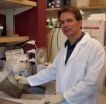A speed gun for the Earth's insides
2010-10-28
(Press-News.org) Researchers at the University of Bristol reveal today in the journal Nature that they have developed a seismological 'speed gun' for the inside of the Earth. Using this technique they will be able to measure the way the Earth's deep interior slowly moves around. This mantle motion is what controls the location of our continents and oceans, and where the tectonic plates collide to shake the surface we live on.
For 2,900 km (1800 miles) beneath our feet, the Earth is made of the rocky mantle. Although solid, it is so hot that it can flow like putty over millions of years. It is heated from below, so that it circulates like water on a stove. While geophysicists know something about how the material moves by the time it reaches the top of the mantle, what goes on at the bottom is still a puzzle. However researchers need to know both to predict how the Earth's surface—our home—will behave.
Andy Nowacki, at the School of Earth Sciences at Bristol University, explained: "The only way to measure the inside of the Earth at such huge depths is with seismic waves. When a large earthquake occurs and waves travel through the Earth, they are affected in different ways, and we can examine their properties to work out what is happening thousands of miles beneath our feet, a region where we can never go. This study focusses on a mysterious layer where the mantle meets the core, a sphere of iron at the centre of the Earth 7,000 km (4400 miles) across. This part just above the core has curious properties which we can measure using seismic waves that pass through it."
This enigmatic part of the Earth is known as D″ (pronounced 'dee-double-prime'). Dr James Wookey said: "We believe that D″ is made from crystals which line up in a certain orientation when the mantle flows. We can measure how they line up, and in this study we do this for one part of the world – North and Central America. In the future our method can then be used to see which direction the mantle is moving everywhere."
Professor Mike Kendall added: "This part of the Earth is incredibly important. The lowermost mantle is where two colossal, churning engines—the mantle and the core—meet and interact. The core is moving very quickly and creates our magnetic field which protects us from the Sun's rays. The mantle above is sluggish, but drives the motion of the plates on the Earth's surface, which build mountains, feed volcanoes and cause earthquakes. Measuring the flow in the lowermost mantle is vital to understanding the long term evolution of the Earth."
INFORMATION: END
ELSE PRESS RELEASES FROM THIS DATE:
2010-10-28
Green tea does not protect against breast cancer. A study of data from approximately 54,000 women, published in BioMed Central's open access journal Breast Cancer Research, found no association between drinking green tea and breast cancer risk.
Motoki Iwasaki, from the National Cancer Center, Tokyo, worked with a team of researchers to carry out the study. He said, "Although in vitro and animal-based studies have suggested that green tea may have beneficial protective effects against breast cancer, results from human studies have been inconclusive. Our large-scale, population-based ...
2010-10-28
In new research published today, researchers uncover evolution in action in cancer cells. They show the forces of evolution in pancreatic tumours mean that not only is cancer genetically different between different patients, but each new focus of cancer spread within a patient has acquired distinct mutations.
Effectively, ten different foci of cancer spread are ten different, but related, tumours. The complexity of pancreatic cancer genetics uncovered in this work helps to explain the difficulty of treating the disease but also strengthens the need for improved methods ...
2010-10-28
(SALT LAKE CITY)—Just seven months after University of Utah geneticists took part in a landmark study that sequenced for the first time the genome of an entire Utah family, U of U researchers have taken part in another historic study that is the first large-scale genome sequencing project – 179 people representing three continents – and 60 Utahns played a major role in this study, too.
Published Wednesday, Oct. 27, 2010, in Nature, the study demonstrates how quickly the science of genome sequencing is expanding – first from individuals, then to families, and now to large ...
2010-10-28
BOSTON--A new oral drug caused dramatic shrinkage of a patient's rare, aggressive form of soft-tissue cancer that was driven by an abnormally activated protein, physician-scientists from Dana-Farber Cancer Institute report in the Oct. 28 issue of the New England Journal of Medicine.
A second patient who had a similar tumor that was not fueled by the mutant protein, called ALK (named for the first disease in which it was found, anaplastic lymphoma kinase), failed to respond to the drug, said the researchers, confirming the inhibitor's specificity for the abnormal protein. ...
2010-10-28
Scientists have invented methods to scout the human genome's repetitive landscapes, where DNA sequences are highly identical and heavily duplicated. These advances, as reported today in Science, can identify subtle but important differences among people in the number and content of repeated DNA segments.
These copy number variations partly account for the normal diversity among people. Copy number variations might also be why some people, and not others, have certain disorders or disease susceptibilities, and might also determine how severely they are affected.
Until ...
2010-10-28
STANFORD, Calif. — The immune system may play a critical role in ensuring the success of certain types of cancer therapies, according to a new study by researchers at the Stanford University School of Medicine. The research showed treatments that disable cancer-promoting genes called oncogenes are much more successful in eradicating tumors in the presence of a signaling molecule secreted by kind of immune cell called a T helper cell.
The finding is important because many drugs now in use in humans are often tested in lab animals with weakened immune systems and many human ...
2010-10-28
PASADENA, Calif.—Five years ago, neuroscientist Christof Koch of the California Institute of Technology (Caltech), neurosurgeon Itzhak Fried of UCLA, and their colleagues discovered that a single neuron in the human brain can function much like a sophisticated computer and recognize people, landmarks, and objects, suggesting that a consistent and explicit code may help transform complex visual representations into long-term and more abstract memories.
Now Koch and Fried, along with former Caltech graduate student and current postdoctoral fellow Moran Cerf, have found ...
2010-10-28
Pancreatic tumors are one of the most lethal cancers, with fewer than five percent of patients surviving five years after diagnosis. But a new study that peers deeply into the genetics of pancreatic cancer presents a bit of good news: an opportunity for early diagnosis. In contrast to earlier predictions, many pancreatic tumors are, in fact, slow growing, taking nearly 20 years to become lethal after the first genetic perturbations appear.
"There have been two competing theories explaining why pancreatic cancers are so lethal," says Bert Vogelstein, the Howard Hughes ...
2010-10-28
Small genetic differences between individuals help explain why some people have a higher risk than others for developing illnesses such as diabetes or cancer. Today in the journal Nature, the 1000 Genomes Project, an international public-private consortium, published the most comprehensive map of these genetic differences, called variations, estimated to contain approximately 95 percent of the genetic variation of any person on Earth.
Researchers produced the map using next-generation DNA sequencing technologies to systematically characterize human genetic variation ...
2010-10-28
VICTORIA – Industrial-scale aquaculture production magnifies environmental degradation, according to the first global assessment of the effects of marine finfish aquaculture (e.g. salmon, cod, turbot and grouper) released today. This is true even when farming operations implement the best current marine fish farming practices.
Dr. John Volpe and his team at the University of Victoria developed the Global Aquaculture Performance Index (GAPI), an unprecedented system for objectively measuring the environmental performance of fish farming.
"Scale is critical," said Dr. ...
LAST 30 PRESS RELEASES:
[Press-News.org] A speed gun for the Earth's insides


